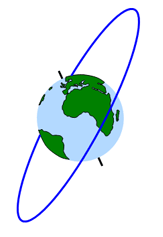Geosynchronous orbit: Difference between revisions
From Halopedia, the Halo wiki
No edit summary |
mNo edit summary |
||
| Line 1: | Line 1: | ||
{{Era| | {{Era|Human|UNSC|HCW|RW}} | ||
{{references}} | {{references}} | ||
{{SeeWikipedia}} | {{SeeWikipedia}} | ||
| Line 5: | Line 5: | ||
A '''geosynchronous orbit''' is an orbit around a planet with an orbital period matching the planet's sidereal rotation period. The term geosynchronous can be used to describe any orbital pattern with a period equal to that of its orbiting body, and in the same direction as the parent's rotation, but is specifically used for orbits with no inclination and a semimajor axis of equal length to the minor axis (i.e. circular). Satellites in geosynchronous orbits appear to maintain their longitude, while their latitude oscillates in a 24-hour period. The geosynchronous orbit over the equator is called the '''geostationary orbit'''. Satellites in the geostationary orbit appear stationary relative to the planet's surface. | A '''geosynchronous orbit''' is an orbit around a planet with an orbital period matching the planet's sidereal rotation period. The term geosynchronous can be used to describe any orbital pattern with a period equal to that of its orbiting body, and in the same direction as the parent's rotation, but is specifically used for orbits with no inclination and a semimajor axis of equal length to the minor axis (i.e. circular). Satellites in geosynchronous orbits appear to maintain their longitude, while their latitude oscillates in a 24-hour period. The geosynchronous orbit over the equator is called the '''geostationary orbit'''. Satellites in the geostationary orbit appear stationary relative to the planet's surface. | ||
== Uses == | ==Uses== | ||
[[Orbital defense platform]]s in particular make use of geosynchronous orbits to protect certain ground regions from attack; [[Cairo Station]], for example, orbited over the city of [[Cairo (city)|Cairo]], taking its name. The [[Athens Station]] orbited above [[Greece|Athens, Greece]], while [[Malta Station]] was situated over the island of [[Malta]].<ref>'''[[Halo 2]]''', campaign level ''[[The Armory]]''</ref> The terminus stations of [[space elevator]]s are also anchored to a geosynchronous, near-geostationary orbit.<ref>[http://halo.xbox.com/en-us/intel/theuniverse/locations/gallery/space-tether/e9b2f438-9b5b-477e-8e52-d4e6801e9d5b '''Halo Waypoint''': ''Space Tether'']</ref> | [[Orbital defense platform]]s in particular make use of geosynchronous orbits to protect certain ground regions from attack; [[Cairo Station]], for example, orbited over the city of [[Cairo (city)|Cairo]], taking its name. The [[Athens Station]] orbited above [[Greece|Athens, Greece]], while [[Malta Station]] was situated over the island of [[Malta]].<ref>'''[[Halo 2]]''', campaign level ''[[The Armory]]''</ref> The terminus stations of [[space elevator]]s are also anchored to a geosynchronous, near-geostationary orbit.<ref>[http://halo.xbox.com/en-us/intel/theuniverse/locations/gallery/space-tether/e9b2f438-9b5b-477e-8e52-d4e6801e9d5b '''Halo Waypoint''': ''Space Tether'']</ref> | ||
==List of appearances== | |||
*''[[Halo 2]]'' | |||
*''[[Halo: Contact Harvest]]'' | |||
*''[[Halo: Ghosts of Onyx]]'' | |||
==Sources== | ==Sources== | ||
<references/> | <references/> | ||
[[Category:Astronomy]] | [[Category:Astronomy]] | ||
Revision as of 19:19, December 11, 2011
| This article does not have enough inline citations and/or does not adhere to the proper citation format. You can help Halopedia by adding citations. |
A geosynchronous orbit is an orbit around a planet with an orbital period matching the planet's sidereal rotation period. The term geosynchronous can be used to describe any orbital pattern with a period equal to that of its orbiting body, and in the same direction as the parent's rotation, but is specifically used for orbits with no inclination and a semimajor axis of equal length to the minor axis (i.e. circular). Satellites in geosynchronous orbits appear to maintain their longitude, while their latitude oscillates in a 24-hour period. The geosynchronous orbit over the equator is called the geostationary orbit. Satellites in the geostationary orbit appear stationary relative to the planet's surface.
Uses
Orbital defense platforms in particular make use of geosynchronous orbits to protect certain ground regions from attack; Cairo Station, for example, orbited over the city of Cairo, taking its name. The Athens Station orbited above Athens, Greece, while Malta Station was situated over the island of Malta.[1] The terminus stations of space elevators are also anchored to a geosynchronous, near-geostationary orbit.[2]
List of appearances
Sources
- ^ Halo 2, campaign level The Armory
- ^ Halo Waypoint: Space Tether
